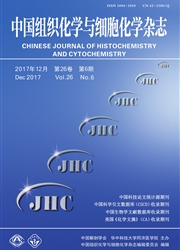

 中文摘要:
中文摘要:
目的探讨创伤后应激障碍(PTSD)大鼠蓝斑神经元β-catenin(β-连环蛋白)的表达变化。方法采用国际认定的SPS方法刺激建立大鼠PTSD模型,取成年健康雄性Wistar大鼠100只,随机分为连续单一刺激(single prolongedstress,SPS)模型1d、4d、7d、14d组和对照组,应用免疫组化、免疫印迹方法检测PTSD大鼠蓝斑神经元β-catenin的表达变化;透射电镜观察PTSD大鼠蓝斑神经元的超微结构变化。结果经SPS刺激后大鼠蓝斑神经元细胞内β-catenin于1d开始逐渐减少,14d表达最少;蓝斑神经元出现细胞凋亡改变。结论蓝斑神经元细胞凋亡可能是导致PTSD患者蓝斑功能失调的重要原因之一。
 英文摘要:
英文摘要:
Objective To investigate the expression of β-catenin in the locus coeruleus of rats with post-traumatic stress disorder (PTSD) . Methods The SPS-method was used to set up the rat PTSD models. A total of 100 health , male Wistar rats were randomly divided into 1, 4, 7 and 14d groups of single prolonged stress ( SPS ) and a normal control group. Immunohistochemistry , immunofluorescence,and western blot were used to observe and detect the changes in the expression of β-catenin in the locus coeruleus neurons, while ultrastructure was detected by electron microscopy. Results Apoptotic cells were present in the locus coeruleus of PTSD rats. The expression of β-catenin in the locus coeruleus gradually decreased from ld after SPS, and reached the minimum at SPS 14d. Conclusion The changes of β-catenin expression in the locus coeruleus may play important roles in the dysfunction of the locus coeruleus in PTSD patients
 同期刊论文项目
同期刊论文项目
 同项目期刊论文
同项目期刊论文
 Single-prolonged stress induces apoptosis in the amygdala in a rat model of post-traumatic stress di
Single-prolonged stress induces apoptosis in the amygdala in a rat model of post-traumatic stress di Activitity of the 5-HT 1A receptor is involved in the alteration of glucocorticoid receptor in hippo
Activitity of the 5-HT 1A receptor is involved in the alteration of glucocorticoid receptor in hippo Increased phosphorylation of extracellular signal-regulated kinase in the medial prefrontal cortex o
Increased phosphorylation of extracellular signal-regulated kinase in the medial prefrontal cortex o Changes of Bax, Bcl- 2 and apoptosis in hippocampus in the rat model of post-traumatic stress disord
Changes of Bax, Bcl- 2 and apoptosis in hippocampus in the rat model of post-traumatic stress disord 期刊信息
期刊信息
